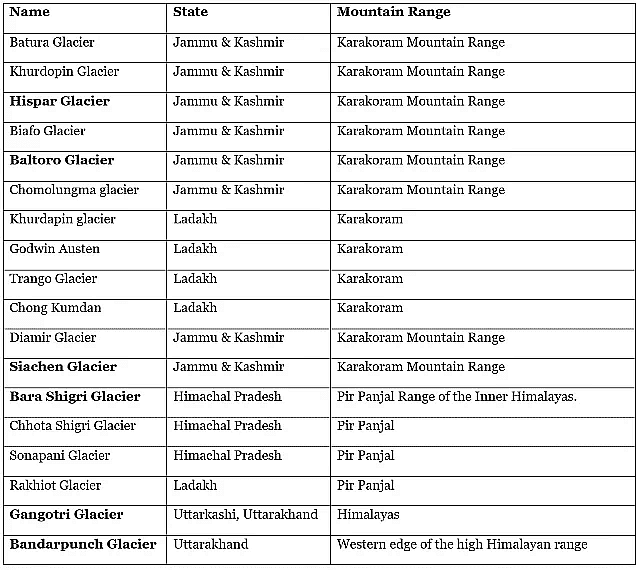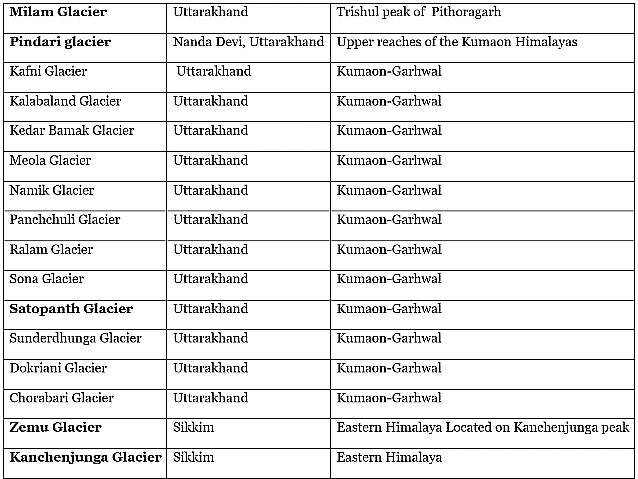UPSC Exam > UPSC Notes > Important Glaciers in India
Important Glaciers in India - UPSC PDF Download
Introduction
Glaciers are a bulk of ice moving under its weight. It forms in areas where the amassing of snow goes beyond its ablation over many years. They are sensitive indicators of changing climate.
- They are generally seen in the snow-fields.
- This largest freshwater basin covers around 10 percent of the land surface of the Earth.
- Out of total water on Earth, 2.1% is in glaciers while 97.2% is in the oceans and inland seas.
- Condition of glacier formation:
- Mean annual temperatures are close to the freezing point.
- Winter precipitation produces significant accumulations of snow.
- Temperatures throughout the rest of the year do not result in the complete loss of the previous winter’s snow accumulation.
- According to the topography and the location of the glacier, it can be categorized as Mountain Glacier (Alpine Glaciers) or Continental Glacier (Ice Sheets).
- The Continental Glacier moves outward in all directions whereas the Mountain Glacier moves from a higher to a lower altitude.
Alpine Glaciers
- Alpine glaciers are formed on the mountainsides and they usually move downwards through the valleys.
- There are times when an alpine glacier also deepens the valleys by pushing away the dirt, soil, and other materials.
- These glaciers are found in high mountains.
Ice Sheets
- Ice sheets form broad domes and usually spread out in all directions.
- When the ice sheets spread, they cover all the areas such as valleys, plains, and mountains with a thick blanket of ice.
- The continental glaciers are the largest ice sheets and cover most of Antarctica and islands of Greenland.
Geographical Location of Glaciers
- 91% of the Glaciers are in Antarctica and 8% are in Greenland. They occupy about 10% of the world’s total land area.

Important Glaciers in India


Glaciers in Himalayas
- There are about 15,000 glaciers in the Himalayas.
- Total area of Himalayas is about five lakh square kilometres (Area of India is nearly 32 lakh sq km). About 33,000 sq km area is covered by snow.
- The snow line (the lowest level of perpetual snow) varies in different parts of the Himalayas depending upon latitude, amount of precipitation and local topography.
Glaciers of the Karakoram Range
- Maximum development of glaciers occurs in the Karakoram range.
- Some of the largest glaciers outside the polar and sub-polar regions are found in this range. The southern side of this range has many gigantic glaciers.
- The 75 km long Siachen Glacier in Nubra valley has the distinction of being the second largest glacier outside the polar and the sub-polar regions. The largest is the 77 km long Fedchenko Glacier (Pamirs)
- Third largest is the Hispar Glacier. It is 62 km long and occupies a tributary of the Hunza River.
Glaciers of the Pir Panjal Range
- The glaciers of the Pir Panjal Range are less numerous and smaller in size as compared to those of the Karakoram Range.
- The longest Sonapani Glacier in the Chandra Valley of Lahul and Spiti region is only 15 km long.
Glaciers of the Kumaon-Garhwal Region
- In the Kumaon-Garhwal region of the Himalayas, the largest is the 30 km long Gangotri Glacier which is the source of the holy Ganga.
Garhwal Region
- Lying in the Himalayas, it is bounded on the north by Tibet, on the east by Kumaon region, on the south by Uttar Pradesh state, and on the northwest by Himachal Pradesh state.
- It includes the districts of Chamoli, Dehradun, Haridwar, Pauri Garhwal, Rudraprayag, Tehri Garhwal, and Uttarkashi.
Glaciers of Central Nepal
- Zemu and the Kanchenjunga glaciers are the major ones.
Gangotri Glacier
- Largest Glacier in Uttarakhand.
- Source of the Ganges. (River Bhagirathi)
- The Gangotri glacier originates at the northern slope of Chaukhamba range of peaks in Garhwal Himalayas.
- Gangotri is not a single valley glacier, but a combination of several other glaciers.
- Carbon Deposits on Gangotri
- The Wadia Institute of Himalayan Geology is an Autonomous Institute administered by the Department of Science and Technology.
- They have the Chirbasa station at a height of 3,600 m and Bhojbasa station at a height of 3,800 m.
- They research the number of carbon deposits on the important glaciers of the Himalayas. Gangotri being the source of the Ganges is one of the most important Glaciers in the country.
- According to recent data from the research, the concentration of Black Carbon present on the Gangotri Glacier has doubled when compared to the results of the past few years.
- The primary reason for this is the agricultural burning and forest fires in the nearby regions.

Siachen Glacier
- Located over the Karakoram Range in the Nubra Valley, is the second largest glacier outside the polar and sub-polar regions
- Lolofond and Teram Shehr are its main tributaries
- Disputed between India and Pakistan
- Highest battle field of the world
Fedchenko
- The Fedchenko Glacier is a large glacier in the Yazgulem Range, Pamir Mountains, of north-central Gorno-Badakhshan province, Tajikistan.
- Largest glacier after the Siachen
- It covers an area of 450 sq. km in the north western Pamir and has nearly 550m deep ice.
Hispar
- Third largest glacier of the Karakoram region, occupies a tributary of the Hunza River
- Combines with Biafo Glacier occupying about 65 sq. km area of Braldoh Valley
- Kunyong /Lak (24 km) is an important tributary of Hispar.

Biafo
- Located between Hispar and Baltoro glaciers, occupies the Braldoh Valley
- 4th largest glacier of the Karakoram region
- Occipies the valley of the Gori Ganga River
- Formed by the union of nine glaciers
Pindari
- Located to the south of the Nanda Devi in northeast Uttarakhand
- Source of the Pindar River
- Located in the Upper reaches of the Kumaon Himalayas
- Provides a 90 km round trip trek.
Rongbuck
- Tibetan side of the Mount Everest
- Largest glacier outside the Karakoram
- Famous Rongbuck Monastery is located at the northern end of the Rougbuk Valley
- Englishman George Mallory first explored while searching possible routes to the summit of the Mount Everest
Zemu
- Flows in easterly direction at the head of the Zemu River
- About one kilometre wide and 180m thick
- Largest glacier of the Eastern Himalayas (26 km)
- Found at the base of the Kanchanjunga
- One of the possible sources of the Teesta River
Baltoro
- A 65 km long glacier over the Karakoram range, west of the siachen glacier.
- It gives rise to the shigar river, a tributary of the Indus river.
FAQs on Important Glaciers in India - UPSC
| 1. What are the important glaciers in India? |  |
Ans. Some of the important glaciers in India include Gangotri Glacier, Yamunotri Glacier, Siachen Glacier, Zemu Glacier, and Milam Glacier.
| 2. What is the significance of Gangotri Glacier? |  |
Ans. Gangotri Glacier is one of the largest glaciers in the Himalayas and the source of the River Ganges. It holds immense religious significance for Hindus and is visited by thousands of pilgrims every year.
| 3. Where is Siachen Glacier located? |  |
Ans. Siachen Glacier is located in the eastern Karakoram Range of the Himalayas, in the disputed region of Jammu and Kashmir between India and Pakistan.
| 4. How do glaciers contribute to the water resources of India? |  |
Ans. Glaciers in India act as natural reservoirs of freshwater. They store water in the form of ice, which gradually melts during the summer months, providing a steady flow of water to rivers and streams. This meltwater is crucial for irrigation, hydropower generation, and maintaining ecological balance.
| 5. How are glaciers affected by climate change? |  |
Ans. Climate change is causing glaciers in India to melt at an alarming rate. Rising temperatures lead to increased melting, resulting in the shrinking of glaciers. This not only affects the availability of freshwater but also poses risks of glacial lake outbursts and changes in river patterns, impacting agriculture, biodiversity, and the overall ecosystem.
Download as PDF

|
Explore Courses for UPSC exam
|

|
Signup for Free!
Signup to see your scores go up within 7 days! Learn & Practice with 1000+ FREE Notes, Videos & Tests.
Related Searches




















